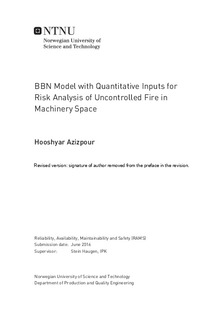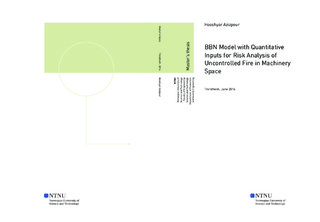| dc.description.abstract | The past decades has witnessed a significant increase in the number and volume of international trade through the sea. Thousands of ships are sailing in the coastal and international waters all over the world. Accident in the sea transport not only results loss of property for the owners of vessels and traders of cargo, but also threatens the environment and the humans who are directly or indirectly associated with the marine industry. One of the most dangerous accidents in ships is fire and statistics has shown more than 50% of the fires in the ships has happened in the aft area of the ship (MEPC 2008). Engine room of the ships by nature is susceptible to fire due to enclosing numbers of ignition sources connected to the pipes and storage tanks containing flammable liquids. In light of the increasing demand for higher level of safety in maritime transport international regulation concerning safety has been upgraded. Frameworks, procedures and regulations concerning fire safety in ships reflected in SOLAS chapter II-2. The accident reports shows that despite of the innovation and preventive regulations and measures, still the risk/frequency of fire is not low enough to be negligible. The critic to the regulation enforced by IMO through chapter II-2 SOLAS is that the rules are achieved largely based on past experiences and assessment of finite set of serious accident scenarios (Mermiris, et al. 2012). Literature review showed there is lack of literature in developing a risk model that can incorporate all the human, organizational and technical factors associated with risk of fire in engine room, which can be used for further analysis and revision of procedures and regulation concerning fire in machinery space.
This report reviewed the statistical reports in the literature about source and frequency of fire in the ships with focus on engine room fire. The influencing factors associated with the risk of uncontrolled fire in engine room identified. The main source of uncontrolled fire presented to be combustion of released hydrocarbons in contact with the ignition sources. Sources of leakage in engine rom classified to two main separated compartments of Purifier Room and Engine Room area. Engine room area includes Main Engine, Diesel Generators, Boiler, Incinerator, and other piping and electrical sources.
The probability/frequency of all of the risk influencing factors determined using the relevant literatures. BBN model developed for uncontrolled fire in engine room. Influence of different factors on each other discussed and the most appropriate probabilities/frequencies selected for the model. As a part of the further work (in order to determine weights for factors in the model) a pairwise comparison method introduce which needs a degree of expert judgment. For the final step, a semi mechanistic approach introduced for developing the conditional probability tables. Sensitivity analysis recommended for identification of the most critical factors that their change might have the highest influence on outcome of the model.
The advantage of the BBN model in this report is that the model includes the most significant technical, human and organizational factors, which are standard in most of the ships. This property of the suggested model makes is applicable for analysis of fire in engine room of any type of ship in any part of the world. The suggested method for quantification of the network, instead of just relying on either expert judgment or statistical data, introduced an approach, which uses combination of both method and gives result that is more realistic. | |


